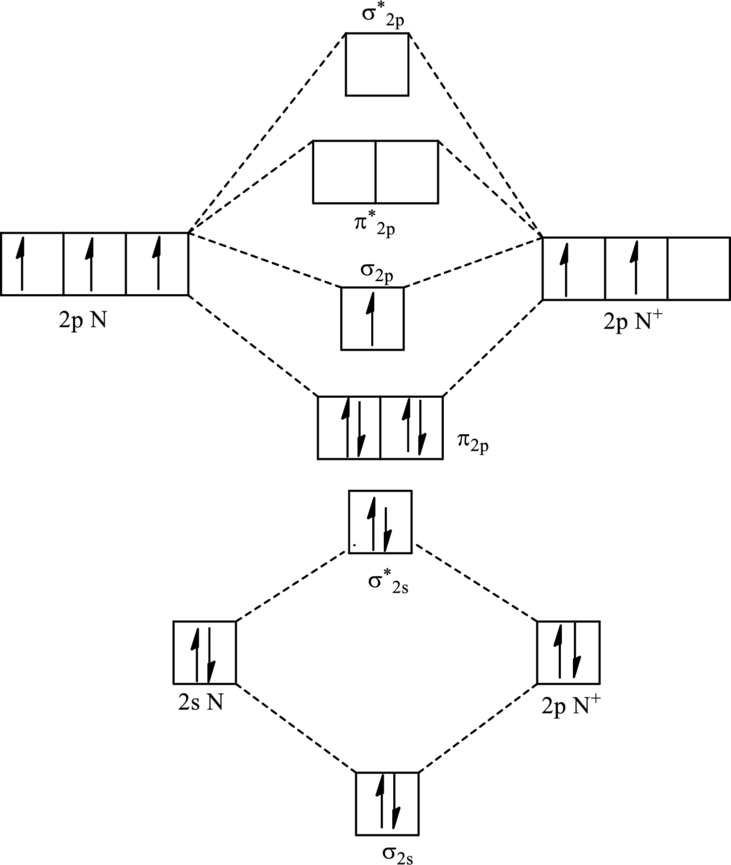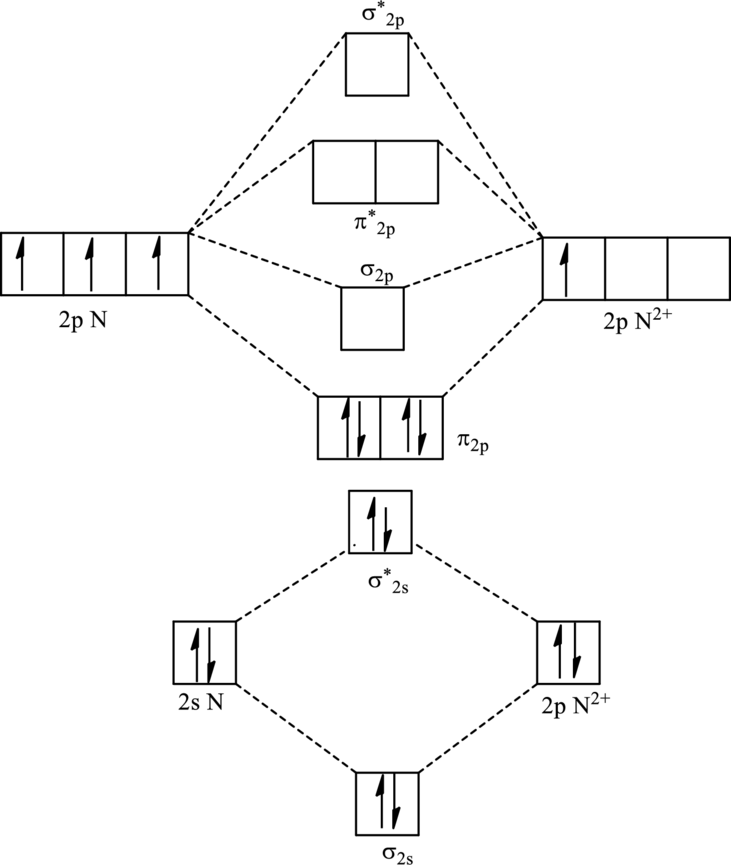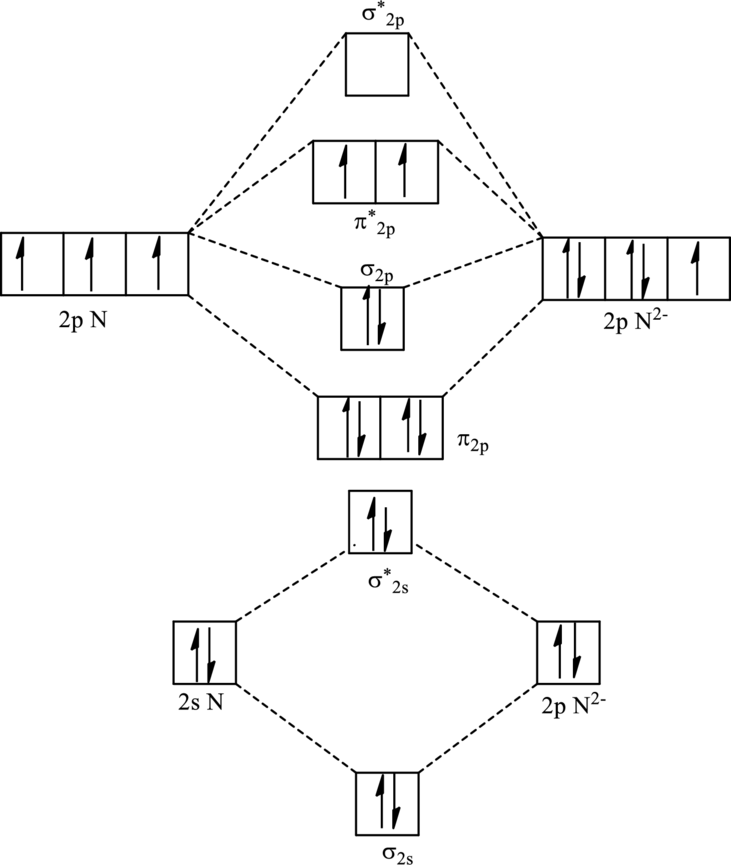
Concept explainers
(a)
Interpretation:
Valence shell electronic configuration of
Concept Introduction:
Molecular orbital diagram is a linear combination of atomic orbitals of similar energy and similar symmetry. It is formed by the proper overlap of the atomic orbitals.
There are 3 types of molecular orbitals as follows:
1. Bonding molecular orbital: They are formed by the constructive interference of atomic orbitals and electrons in it stabilize the molecule and are of lesser in energy.
2. Antibonding molecular orbital: This type of orbitals increases the energy of molecule and destabilizes it and weakens the bond between the atoms.
3. Non-bonding molecular orbital: These types of orbitals have energy similar to atomic orbitals that is addition or removal of electron does not change the energy of molecule.
The order of energy in molecular orbital follows two rules as follows:
1. For
2. For atomic number more than 14 order of energy is,
(a)
Explanation of Solution
For
The symbol for nitrogen is
One positive charge is added up in the total valence count.
Thus total valence electrons is sum of the valence electrons for each atom in
Hence, 9 electrons are to be arranged in each molecular orbital to obtain an electronic configuration. Since number of electrons in
Hence, the electronic configuration of
For
The symbol for nitrogen is
Two positive charges are subtracted from the total valence count.
Thus total valence electrons are sum of the valence electrons for each atom in
Hence, 8 electrons are to be arranged in each molecular orbital to obtain an electronic configuration. Since number of electrons in
Hence, the electronic configuration of
For
The symbol for nitrogen is
Two negative charges are added up in total valence count.
Thus total valence electrons are sum of the valence electrons for each atom in
Hence, 12 electrons are to be arranged in each molecular orbital to obtain an electronic configuration. Since number of electrons in
Hence, the electronic configuration of
(b)
Interpretation:
The bond order of
Concept Introduction:
Bond order
(b)
Explanation of Solution
For
The electronic configuration of
Substitute 7 for number of electrons in bonding orbitals and 2 for number of electrons in antibonding orbitals in equation (1) to calculate bond order.
Hence, the bond order of the molecule
For
The electronic configuration of
Substitute 6 for number of electrons in bonding orbitals and 2 for number of electrons in antibonding orbitals in equation (1) to calculate bond order.
Hence, the bond order of the molecule
For
The electronic configuration of
Substitute 8 for number of electrons in bonding orbitals and 4 for number of electrons in antibonding orbitals in equation (1) to calculate bond order.
Hence, the bond order of the molecule
(c)
Interpretation:
Molecular orbital diagram of
Concept Introduction:
Refer to (a)
(c)
Explanation of Solution
For
The electronic configuration of

Since
For
The electronic configuration of

Since
For
The electronic configuration of

Since
(d)
Interpretation:
Character of highest energy orbital of
Concept Introduction:
Refer to (a)
(d)
Explanation of Solution
For
The electronic configuration of
For
The electronic configuration of
For
The electronic configuration of
Want to see more full solutions like this?
Chapter 2 Solutions
CHEMICAL PRINCIPLES (LL) W/ACCESS
- Hand written equations pleasearrow_forwardHand written equations pleasearrow_forward> each pair of substrates below, choose the one that will react faster in a substitution reaction, assuming that: 1. the rate of substitution doesn't depend on nucleophile concentration and 2. the products are a roughly 50/50 mixture of enantiomers. Substrate A Substrate B Faster Rate X Ś CI (Choose one) (Choose one) CI Br Explanation Check Br (Choose one) © 2025 McGraw Hill LLC. All Rights Farrow_forward
- NMR spectrum of ethyl acetate has signals whose chemical shifts are indicated below. Which hydrogen or set of hydrogens corresponds to the signal at 4.1 ppm? Select the single best answer. The H O HỌC—C—0—CH, CH, 2 A ethyl acetate H NMR: 1.3 ppm, 2.0 ppm, 4.1 ppm Check OA B OC ch B C Save For Later Submit Ass © 2025 McGraw Hill LLC. All Rights Reserved. Terms of Use | Privacy Center |arrow_forwardHow many signals do you expect in the H NMR spectrum for this molecule? Br Br Write the answer below. Also, in each of the drawing areas below is a copy of the molecule, with Hs shown. In each copy, one of the H atoms is colored red. Highlight in red all other H atoms that would contribute to the same signal as the H already highlighted red Note for advanced students: In this question, any multiplet is counted as one signal. 1 Number of signals in the 'H NMR spectrum. For the molecule in the top drawing area, highlight in red any other H atoms that will contribute to the same signal as the H atom already highlighted red. If no other H atoms will contribute, check the box at right. Check For the molecule in the bottom drawing area, highlight in red any other H atoms that will contribute to the same signal as the H atom already highlighted red. If no other H atoms will contribute, check the box at right. O ✓ No additional Hs to color in top molecule ง No additional Hs to color in bottom…arrow_forwardin the kinetics experiment, what were the values calculated? Select all that apply.a) equilibrium constantb) pHc) order of reactiond) rate contstantarrow_forward
- true or false, given that a 20.00 mL sample of NaOH took 24.15 mL of 0.141 M HCI to reach the endpoint in a titration, the concentration of the NaOH is 1.17 M.arrow_forwardin the bromothymol blue experiment, pKa was measured. A closely related compound has a Ka of 2.10 x 10-5. What is the pKa?a) 7.1b) 4.7c) 2.0arrow_forwardcalculate the equilibrium concentration of H2 given that K= 0.017 at a constant temperature for this reaction. The inital concentration of HBr is 0.050 M.2HBr(g) ↔ H2(g) + Br2(g)a) 4.48 x 10-2 M b) 5.17 x 10-3 Mc) 1.03 x 10-2 Md) 1.70 x 10-2 Marrow_forward
- true or falsegiven these two equilibria with their equilibrium constants:H2(g) + CI2(l) ↔ 2HCI(g) K= 0.006 CI2(l) ↔ CI2(g) K= 0.30The equilibrium contstant for the following reaction is 1.8H2(g) + CI2 ↔ 2HCI(g)arrow_forwardI2(g) + CI2(g) ↔ 2ICIK for this reaction is 81.9. Find the equilibrium concentration of I2 if the inital concentration of I2 and CI2 are 0.010 Marrow_forwardtrue or false,the equilibrium constant for this reaction is 0.50.PCI5(g) ↔ PCI3(g) + CI2(g)Based on the above, the equilibrium constant for the following reaction is 0.25.2PCI5(g) ↔. 2PCI3(g) + 2CI2(g)arrow_forward
 Chemistry: Principles and PracticeChemistryISBN:9780534420123Author:Daniel L. Reger, Scott R. Goode, David W. Ball, Edward MercerPublisher:Cengage Learning
Chemistry: Principles and PracticeChemistryISBN:9780534420123Author:Daniel L. Reger, Scott R. Goode, David W. Ball, Edward MercerPublisher:Cengage Learning Chemistry: Principles and ReactionsChemistryISBN:9781305079373Author:William L. Masterton, Cecile N. HurleyPublisher:Cengage Learning
Chemistry: Principles and ReactionsChemistryISBN:9781305079373Author:William L. Masterton, Cecile N. HurleyPublisher:Cengage Learning

